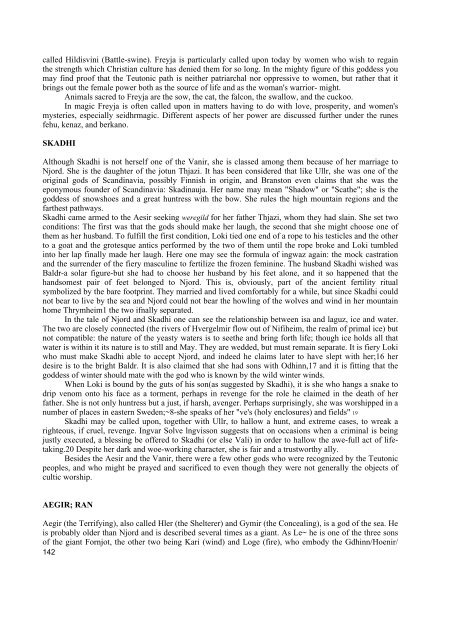TEUTONIC MAGIC - Awaken Video
TEUTONIC MAGIC - Awaken Video
TEUTONIC MAGIC - Awaken Video
Create successful ePaper yourself
Turn your PDF publications into a flip-book with our unique Google optimized e-Paper software.
called Hildisvini (Battle-swine). Freyja is particularly called upon today by women who wish to regain<br />
the strength which Christian culture has denied them for so long. In the mighty figure of this goddess you<br />
may find proof that the Teutonic path is neither patriarchal nor oppressive to women, but rather that it<br />
brings out the female power both as the source of life and as the woman's warrior- might.<br />
Animals sacred to Freyja are the sow, the cat, the falcon, the swallow, and the cuckoo.<br />
In magic Freyja is often called upon in matters having to do with love, prosperity, and women's<br />
mysteries, especially seidhrmagic. Different aspects of her power are discussed further under the runes<br />
fehu, kenaz, and berkano.<br />
SKADHI<br />
Although Skadhi is not herself one of the Vanir, she is classed among them because of her marriage to<br />
Njord. She is the daughter of the jotun Thjazi. It has been considered that like Ullr, she was one of the<br />
original gods of Scandinavia, possibly Finnish in origin, and Branston even claims that she was the<br />
eponymous founder of Scandinavia: Skadinauja. Her name may mean "Shadow" or "Scathe"; she is the<br />
goddess of snowshoes and a great huntress with the bow. She rules the high mountain regions and the<br />
farthest pathways.<br />
Skadhi came armed to the Aesir seeking weregild for her father Thjazi, whom they had slain. She set two<br />
conditions: The first was that the gods should make her laugh, the second that she might choose one of<br />
them as her husband. To fulfill the first condition, Loki tied one end of a rope to his testicles and the other<br />
to a goat and the grotesque antics performed by the two of them until the rope broke and Loki tumbled<br />
into her lap finally made her laugh. Here one may see the formula of ingwaz again: the mock castration<br />
and the surrender of the fiery masculine to fertilize the frozen feminine. The husband Skadhi wished was<br />
Baldr-a solar figure-but she had to choose her husband by his feet alone, and it so happened that the<br />
handsomest pair of feet belonged to Njord. This is, obviously, part of the ancient fertility ritual<br />
symbolized by the bare footprint. They married and lived comfortably for a while, but since Skadhi could<br />
not bear to live by the sea and Njord could not bear the howling of the wolves and wind in her mountain<br />
home Thrymheim1 the two ifnally separated.<br />
In the tale of Njord and Skadhi one can see the relationship between isa and laguz, ice and water.<br />
The two are closely connected (the rivers of Hvergelmir flow out of Nifiheim, the realm of primal ice) but<br />
not compatible: the nature of the yeasty waters is to seethe and bring forth life; though ice holds all that<br />
water is within it its nature is to still and May. They are wedded, but must remain separate. It is fiery Loki<br />
who must make Skadhi able to accept Njord, and indeed he claims later to have slept with her;16 her<br />
desire is to the bright Baldr. It is also claimed that she had sons with Odhinn,17 and it is fitting that the<br />
goddess of winter should mate with the god who is known by the wild winter winds.<br />
When Loki is bound by the guts of his son(as suggested by Skadhi), it is she who hangs a snake to<br />
drip venom onto his face as a torment, perhaps in revenge for the role he claimed in the death of her<br />
father. She is not only huntress but a just, if harsh, avenger. Perhaps surprisingly, she was worshipped in a<br />
number of places in eastern Sweden;~8-she speaks of her "ve's (holy enclosures) and fields" 19<br />
Skadhi may be called upon, together with Ullr, to hallow a hunt, and extreme cases, to wreak a<br />
righteous, if cruel, revenge. Ingvar Solve lngvisson suggests that on occasions when a criminal is being<br />
justly executed, a blessing be offered to Skadhi (or else Vali) in order to hallow the awe-full act of lifetaking.20<br />
Despite her dark and woe-working character, she is fair and a trustworthy ally.<br />
Besides the Aesir and the Vanir, there were a few other gods who were recognized by the Teutonic<br />
peoples, and who might be prayed and sacrificed to even though they were not generally the objects of<br />
cultic worship.<br />
AEGIR; RAN<br />
Aegir (the Terrifying), also called Hler (the Shelterer) and Gymir (the Concealing), is a god of the sea. He<br />
is probably older than Njord and is described several times as a giant. As Le~ he is one of the three sons<br />
of the giant Fornjot, the other two being Kari (wind) and Loge (fire), who embody the Gdhinn/Hoenir/<br />
142
















